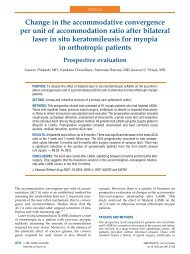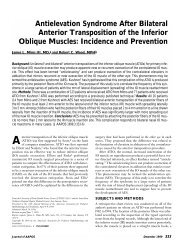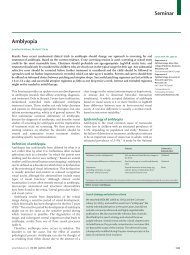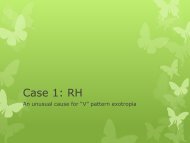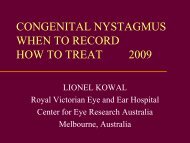What's new AAPOS 2008 - The Private Eye Clinic
What's new AAPOS 2008 - The Private Eye Clinic
What's new AAPOS 2008 - The Private Eye Clinic
You also want an ePaper? Increase the reach of your titles
YUMPU automatically turns print PDFs into web optimized ePapers that Google loves.
METHODS: Thirteen pediatric patients aged one to 15 years with a traumatic macular<br />
hole underwent surgical repair. All patients underwent surgery between February 1997<br />
and March 2005 with autologous plasmin enzyme-assisted vitrectomy. After induction of<br />
posterior vitreous detachment (PVD), vitrectomy with membrane peeling and gas or<br />
silicone oil injection were performed followed by prone positioning for seven days. Main<br />
outcome measures included anatomic closure rate, visual outcome, and ocular<br />
complications.<br />
RESULTS: <strong>The</strong> macular hole was closed successfully in 12 (92%) of 13 cases. Of the<br />
12 patients for whom vision could be measured, 11 patients (92%) had visual acuity<br />
improvement of 2 or more lines and six patients (50%) achieved vision of 20/50 or<br />
better; all of the patients achieved vision better than 20/200. <strong>The</strong> visual improvement<br />
was statistically significant (P = .005, Wilcoxon signed-rank test). Surgical complications<br />
included cataract formation in one patient and retinal detachment in one patient.<br />
CONCLUSIONS: Autologous plasmin enzyme may be a helpful adjunct when<br />
performing vitrectomy for traumatic macular holes.<br />
Profile of the retina by optical coherence tomography in the pediatric age group.<br />
Gupta G, Donahue JP, You T.<br />
Am J Ophthalmol. 2007 Aug;144(2):309-10.<br />
PURPOSE: To establish normative values of the retina in the pediatric population using<br />
optical coherence tomography (OCT).<br />
METHODS: Prospective study examining macular thickness and nerve fiber layer<br />
thickness in children with no ocular disease. After clinical examination, patients meeting<br />
the inclusion and exclusion criteria underwent OCT scanning.<br />
RESULTS: Thirty-two eyes were examined for macular thickness and 25 eyes for nerve<br />
fiber layer thickness. Normative values are found in the Table. <strong>The</strong> average foveal<br />
thickness for children is 221 microns vs 182 microns in adults.<br />
CONCLUSION: This study demonstrates normative values of retinal thickness and<br />
retinal nerve fiber layer (RNFL) thickness in the pediatric age group. Children have<br />
slightly thicker maculas than adults; the RNFL thickness is comparable to adults.<br />
Relationship of axial length and retinal vascular caliber in children.<br />
Cheung N, Tikellis G, Saw SM, Amirul Islam FM, Mitchell P, Wang JJ, Wong TY.<br />
Am J Ophthalmol. 2007 Nov;144(5):658-662. Epub 2007 Sep 17.<br />
PURPOSE: Previous studies in older adults suggest that longer axial length is<br />
associated with narrower arteriolar caliber. In this study, we re-examined this<br />
relationship in a cohort of children, while controlling for the effects of ocular<br />
magnification. DESIGN: Cross-sectional study of 767 children aged 7 to 9 years.<br />
METHODS: Retinal vascular calibers were measured from retinal photographs using a<br />
computer-based program. Ocular magnification was corrected using the Bengtsson<br />
formula. Standardized examination of refraction and ultrasound ocular biometry was<br />
performed for all children.<br />
84



